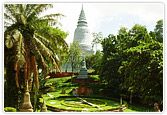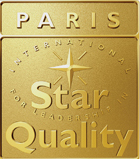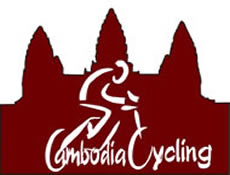

Phnom Penh Information:
- Province: Phnom Penh
- Area: 290 sq km
- Population: 1,184,594
- Density: 3,448
- Khan: 7
- Sangkat: 76
- Village: 637
Phnom Penh is the capital of Cambodia city. It does have an eccentric charm. Seen from the river, palm trees and the pagoda-like spires of Khmer royal buildings rise over French-era shop houses and villas. In the 1950s and 1960s this was one of the finest cities in Southeast Asia. The riverine city's yellow-ocher buildings, squares and cafes, and frangipani-lined boulevards give it the atmosphere of a French provincial town. The city is located at what the French called Les Quatre Bras (the Four Arms), where two arms of the Mekong meet the Bassac and Tonle Sap tributaries. The city's original name, Chaktomuk, means Four Rivers.
National Museum |
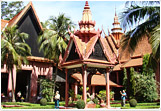 Located just north of the Royal Palace, the National Museum was recently rested to its former glory as one of the finest examples of Khmer architecture. On display there are more than 5,000 artifacts and objects of 'art from the 6th to the 13th centuries. They include sandstone sculptures, royal barges, palanquins and silk, intricately woven with silver and gold threads. There are also rare religious objects in gold, silver and bronze.
Located just north of the Royal Palace, the National Museum was recently rested to its former glory as one of the finest examples of Khmer architecture. On display there are more than 5,000 artifacts and objects of 'art from the 6th to the 13th centuries. They include sandstone sculptures, royal barges, palanquins and silk, intricately woven with silver and gold threads. There are also rare religious objects in gold, silver and bronze.
Royal Palace |
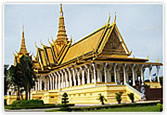 Built in 1866 by His Majesty Preah Bat Norodom, the Royal Palace is now home to his Majesty Preah Bat Nodom Shihanouk and Her majesty Preah Reach Akka-Mohesey Norodom.Most of the buildings inside the palace are closed to the public, except for special occasions. Also within the palace walls is the Silver Pagoda, which draws its name from the 5,000 silver tiles that pave its floor. Inside the pagoda there are hundreds of gifts to Cambodian king, including a solid-gold Buddha encrusted with 9,584 diamonds weighing 90 kilograms. For those who love shopping, there are several markets that offer handicraft, silk, silver ware, wood carving, precious stones from the country's famous mines, as well as antique furniture and paintings by local artists. The ticket is $6.25.
Built in 1866 by His Majesty Preah Bat Norodom, the Royal Palace is now home to his Majesty Preah Bat Nodom Shihanouk and Her majesty Preah Reach Akka-Mohesey Norodom.Most of the buildings inside the palace are closed to the public, except for special occasions. Also within the palace walls is the Silver Pagoda, which draws its name from the 5,000 silver tiles that pave its floor. Inside the pagoda there are hundreds of gifts to Cambodian king, including a solid-gold Buddha encrusted with 9,584 diamonds weighing 90 kilograms. For those who love shopping, there are several markets that offer handicraft, silk, silver ware, wood carving, precious stones from the country's famous mines, as well as antique furniture and paintings by local artists. The ticket is $6.25.S21 Toul Sleng and The Killing Field |
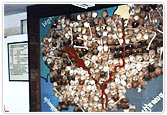 When the Khmer Rouge came to power in 1975 they converted a former high school in the suburbs of Phnom Penh into a detention and torture center known as Toul Sleng, or S-21. A genocide museum was established at Tulo Sleng after 1979 and today it remains as it looked when abandoned by the Khmer Rouge. Hundreds of faces of those tortured line the walls inside the old school. Most of the 17,000 people detained at Toul Sleng were eventually transported to Choeung Ek, a mass gravesite located 15 km outside Phnom Penh. Known to locals as the Killing Field, Choeung Ek serves as a memorial to those killed under the Khmer Rogue rule. These sites can be extremely distressing, but are and essential part of understanding Cambodia’s tragic past. The ticket is $3.
When the Khmer Rouge came to power in 1975 they converted a former high school in the suburbs of Phnom Penh into a detention and torture center known as Toul Sleng, or S-21. A genocide museum was established at Tulo Sleng after 1979 and today it remains as it looked when abandoned by the Khmer Rouge. Hundreds of faces of those tortured line the walls inside the old school. Most of the 17,000 people detained at Toul Sleng were eventually transported to Choeung Ek, a mass gravesite located 15 km outside Phnom Penh. Known to locals as the Killing Field, Choeung Ek serves as a memorial to those killed under the Khmer Rogue rule. These sites can be extremely distressing, but are and essential part of understanding Cambodia’s tragic past. The ticket is $3.Independent Monument |
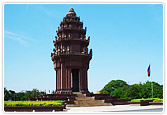
Wat Phnom |
